Testing for a Blown Fuse
How to test a fuse with a multimeter
Whilst it is easy to visually inspect the element in a glass fuse to see if it has blown, the majority of fuses have solid, non-transparent bodies that hide the element from view. To test if the fuse is blown, we require a multimeter. Once configured, a multimeter can measure the resistance of the fuse element. Resistance is measured in Ohms 'Ω'. The following tutorial uses a digital multimeter, however the same principles apply when using an analogue multimeter (ie. one with a needle display). If you are using an analogue meter, firstly read the tutorial and then refer to the additional notes at the end.
Need a replacement fuse? View our large range of fuses.
Connecting the Test Leads.
The black lead should be connected to the Common socket.
The red lead should be connected to the Ω or Ohms socket.
Not sure what fuse you need? We can help.
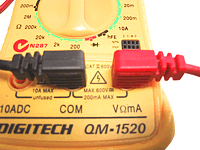
How do you set the ohms on a multimeter.
Move the dial to the lowest range of the Ohms scale (200 ohms is the lowest setting
on this mulitmeter). This should also power the meter ON. If there is a seperate ON switch, please turn the meter ON. You can see in the picture that the Ohms range is illustrated by a light green band in lower left area.
The 5 different Ohms range settings on this multimeter are;
2M = 2,000,000 ohms or 2 Megaohms (highest resistance setting)
200k = 200,000 ohms
20k = 20,000 ohms
2k = 2,000 ohms
200 = 200 ohms (lowest resistance setting)
Our comprehensive Fuse Size Guide can help you find a replacement fuse.
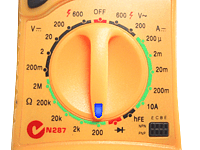
How to test if your multimeter is working.
Touch the metal tips of the 2 testing leads and whilst holding them together, the meter display should change to show that little or no resistance is present. Power will simply flow from one lead back through the other. When you seperate the two tips, the meter display will return to a 100% resistance state.
Measure Resistance of the Fuse.
Important! Place the fuse on a non-conducting surface such as wood, laminate
or plastic. Touch the metal caps at each end of the fuse with the metal tips of the
testing leads. There is no polarity so you can use any lead for either fuse cap. Ensure to make good contact by touching a clean metal surface on each cap.
Whilst the leads are firmly connected to the fuse, look at the reading displayed on the multimeter.
Note: If you wish to test a fuse still located in a circuit. Please ensure that
you have turned off power and disconnected the power source to avoid possibility of electric shock.
Replace your fuses for the best price! We’ll beat any current competitor’s advertised price*

Understanding a Digital Multimeter Reading.
Fuse is OK: If the multimeter reading changes to a low resistance value (similar
to the result of touching the 2 leads together).
Fuse is Blown: If the meter reading does not change and display still shows the original 100% resistance state.
Don't forget to turn the multimeter OFF when you have finished testing.
We offer FREE express shipping anywhere in Australia on all orders over AU$150.00.
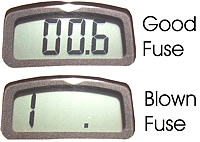
How to use an Analogue Multimeter.
Analogue multimeters provide readings by moving a needle over a fixed scale.
The testing process is exactly the same.
Choose the correct Ohms range & touch the metal tips of the testing leads together.
The needle will 'sweep' across the scale to show little to no resistance. A good fuse will generate the same reading.
When the tips are seperated, the needle will show 100% resistance
state. A blown fuse will generate the same reading. Make sure that the testing lead tips make a good connection to the metal end caps or blades of the fuse and the fuse is tested on a non-conducting surface.
Same day processing of orders received before 2pm Australian Eastern Standard Time.
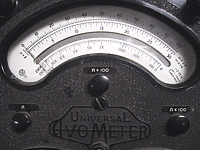
Can a Car Fuse Go Bad Without Blowing?
If your car fuse is not functioning and doesn't appear to have blown, here are some reasons why that may happen;
- 1. The fuse has a manufacturing defect. Is it a quality fuse or a cheap replacement?
- 2. A blown fuse has been replaced incorrectly with a lower rated fuse.
- 3. The device powered by the fuse is faulty, drawing a higher current.
- 4. The fuse is OK, but something went wrong in the testing process.
A car fuse wouldn't commonly fail because of overuse or ageing. Automotive fuses are designed to function for a very long period of time when operated within the manufacturer's specified parameters.
Electrical circuits in modern vehicles are designed by qualified electrical engineers and subjected to rigorous testing in extreme environments so they are usually very reliable. Additionally, car manufacturers use high quality fuses which are manufactured and tested to strict standards.
Want to learn more about fuses? View all fuse tutorials.

How to tell if a Car Fuse is blown?
There are a few ways to quickly check if a car fuse is blown. Firstly, you need to find the fuse
that controls whatever device isn’t working. There may be a diagram inside the fuse box
lid or owner's manual or you can find it online. Then, remove the fuse using fuse pullers - make sure your car
is completely switched off before you do this! Next, inspect the fuse for visual signs of
discoloration or broken filaments. You can then install a replacement car fuse.
Shop our range of car fuses.

Need a Replacement Fuse?
Swe-Check are the Fuse Specialists.
We carry a massive stock range of high quality fuses which you can buy on our website.
If you are unable to find the fuse you require, our expert staff can cross reference fuses between the many different brands. Contact us.
We service all requirements from small retail customers to large OEM companies and distributors and can organise special pricing and credit accounts.
If you are not sure how to identify a fuse, we have created this
fuse identification guide.
We only sell quality approved products by globally recognised manufacturers.
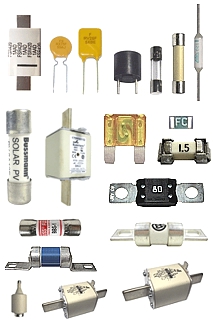
 |
Want to know more? View all fuse tutorials. |




